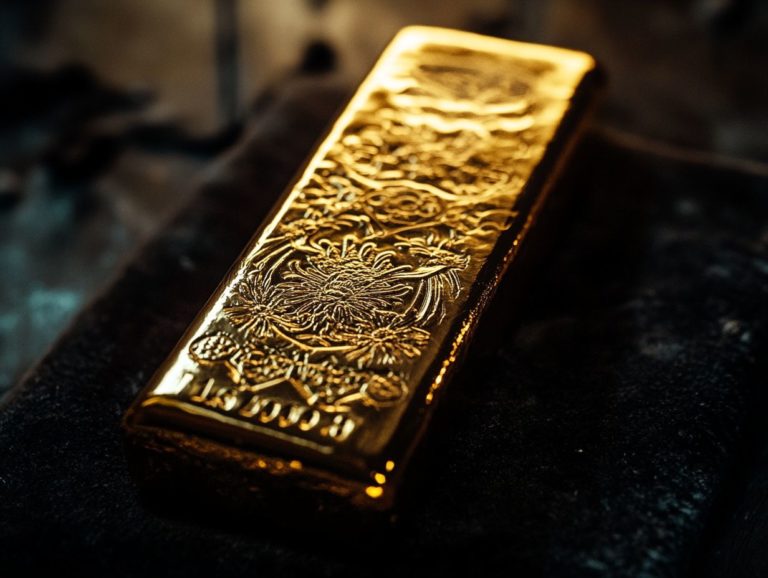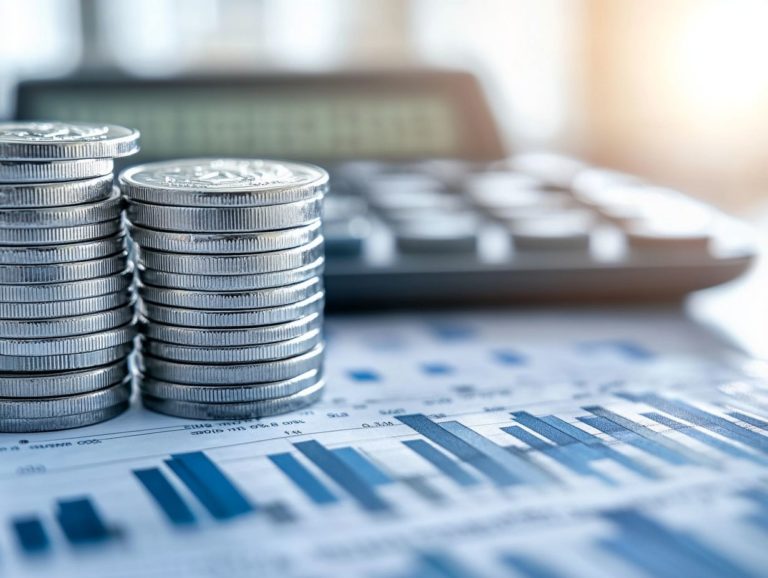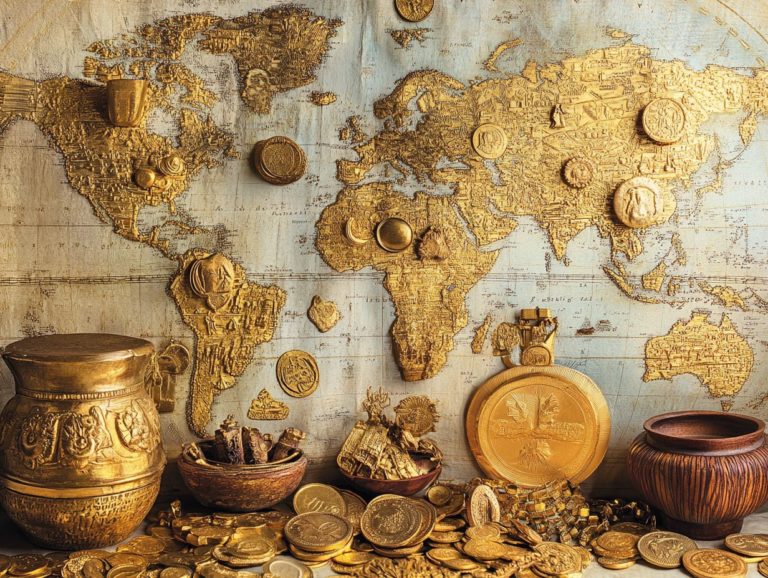The Best Precious Metals for Hedge Against Inflation
In today s uncertain economic landscape, you may find yourself drawn to precious metals as a shield against inflation. Gold, silver, and platinum are among the valuable assets that have consistently held their worth, even when currency values shift unpredictably.
This article explores precious metals, highlighting their unique characteristics and their roles as effective inflation hedges.
You ll uncover investment strategies, historical trends, and potential risks involved, all designed to equip you with the knowledge necessary for making informed decisions.
Discover how to safeguard your wealth in these turbulent times, ensuring that you are prepared for whatever the future holds.
Contents
- Key Takeaways:
- 1. Gold
- 2. Silver
- 3. Platinum
- 4. Palladium
- 5. Rhodium
- 6. Copper
- 7. Nickel
- 8. Cobalt
- 9. Zinc
- 10. Aluminum
- 11. Iron
- 12. Titanium
- 13. Tungsten
- 14. Lead
- 15. Brass
- What Are Precious Metals and How Are They Used as a Hedge Against Inflation?
- Frequently Asked Questions
- What Are the Best Precious Metals for Hedge Against Inflation?
- Why Are These Metals Considered the Best for Hedge Against Inflation?
- How Do These Metals Protect Against Inflation?
- Are There Any Risks Associated with Investing in Precious Metals for Hedge Against Inflation?
- Should I Invest in Physical Precious Metals or in a Precious Metals ETF for Hedge Against Inflation?
- What Are Some Other Ways to Hedge Against Inflation Besides Investing in Precious Metals?
Key Takeaways:
- Gold, silver, platinum, and palladium are the best precious metals for hedging against inflation.
- Their value is not tied to the performance of other assets or the economy.
- Investing in precious metals can be done through physical ownership, exchange-traded funds (ETFs), or mining company stocks.
- It is important to consider the risks and drawbacks associated with these investments.
1. Gold
Gold has always been celebrated as a precious metal and a safe-haven asset for investors. It acts as a hedge against inflation, preserving your purchasing power during market fluctuations and financial instability. Gold is a must-have in your investment portfolio!
Its rich history stretches back thousands of years, during which gold s intrinsic value was acknowledged as both a medium of exchange and a symbol of wealth. In today s investment landscape, it maintains a unique status, often compared with stocks, bonds, and real estate.
While gold prices can experience volatility, its timeless allure lies in its resilience during economic downturns, making it a dependable cornerstone in risk management strategies.
Inflationary pressures are increasing, leading many investors to gravitate toward gold, recognizing its dual role as a commodity and a safeguard against uncertainty a bulwark against the erosion of savings.
2. Silver
Silver, often regarded as gold’s sister precious metal, boasts unique attributes that elevate it as an enticing investment choice. Its appeal stretches to both collectors and investors, thanks to its diverse industrial applications and robust market demand.
This metal’s versatility transcends mere adornment; silver plays a pivotal role in sectors from electronics to solar energy, significantly enhancing its value.
Historically, silver has served as a dependable hedge against inflation, with its price frequently reflecting broader economic trends. When you explore investment returns, you’ll discover that silver offers the potential for substantial gains, especially amidst economic uncertainty.
The market dynamics of silver versus gold are influenced by factors like supply constraints and global demand, making silver an intriguing option for seasoned investors and newcomers alike.
3. Platinum
Platinum, a rarer precious metal than gold and silver, captures attention with its unique investment potential, especially if you seek to diversify your asset classes and collectibles.
This distinctive status enhances its value and unlocks a range of industrial applications, particularly in the automotive sector, where it plays a crucial role in catalytic converters that reduce harmful emissions.
Platinum s involvement in electronics and jewelry further cements its presence in luxury markets. Unlike gold and silver, which often act as traditional safe-haven assets, the market trends for platinum are more susceptible to industrial demand and economic growth.
This makes it an intriguing option as you look to diversify your investment portfolio while keeping an eye on the broader economic landscape.
4. Palladium
Palladium is increasingly important in the precious metals market, driven by rising demand in automotive applications. If you’re looking for high returns, savvy investors are eyeing this metal.
This metal is crucial for making catalytic converters, which help reduce harmful vehicle emissions. This ensures a steady demand, but the market does face challenges.
Geopolitical tensions and shifts in regulations can create price volatility. To navigate these waters successfully, keep informed about market changes.
Palladium can also be a strategic addition to your investment portfolio, providing a hedge against inflation and currency fluctuations.
5. Rhodium
Rhodium may be less commonly traded than gold or silver, but it s known for its extreme price swings. This unique metal is mainly used in catalytic converters, making it worth considering for your investment portfolio.
Its limited availability and specific industrial uses drive fluctuating demand. Unlike gold, often seen as a safe haven, rhodium’s value is closely linked to the automotive sector.
While rhodium offers potential for substantial returns, it also carries significant investment risks. Weigh these carefully against more stable metals like gold and silver.
6. Copper
Copper is viewed as a barometer of economic health and plays a vital role across many industries. It s increasingly recognized as a valuable asset, especially during inflationary periods.
The metal s diverse uses, from wiring to renewable energy technologies, emphasize its industrial importance. As economies modernize, demand for copper continues to rise.
Recent price trends have shown volatility due to geopolitical tensions. This creates opportunities for investors to consider copper as a strong alternative to traditional precious metals.
Many are finding that copper is an attractive investment, helping to hedge against economic uncertainty while meeting industrial needs.
7. Nickel
Nickel is emerging as a key investment, especially due to its role in battery production and stainless steel manufacturing. This growing demand is hard to ignore for savvy investors.
The rise in interest is driven by the global shift toward renewable energy and the surge in electric vehicle production. Both rely heavily on nickel for effective battery performance.
Nickel’s unique properties give it an advantage over other materials. However, be mindful of geopolitical tensions and supply chain issues that can affect its availability.
Understanding these dynamics is essential for making informed investment decisions in today s volatile market.
8. Cobalt
Cobalt is not just a metal; it’s a game-changer for electric vehicles!
Cobalt, an important part of lithium-ion batteries, is witnessing a remarkable surge in interest, positioning it as a compelling option for investors eager to tap into the electric vehicle revolution.
This growing interest comes from the fast rise in electric vehicle production, as well as increasing applications in renewable energy storage systems and consumer electronics.
As industries shift toward more sustainable solutions, cobalt plays a crucial role in enhancing battery efficiency and lifespan.
Recent market trends show changing prices and geopolitical issues surrounding cobalt mining, which tends to be concentrated in specific regions.
Understanding these dynamics equips you with the insights necessary to craft strategic investments in cobalt-related assets, such as mining stocks or Exchange-Traded Funds (ETFs) that focus on battery materials.
Balancing risk and opportunity is key to maximizing your returns. Don’t miss the chance to invest in this rising star of the market!
9. Zinc
Zinc may not shine as brightly as other metals, but it holds a significant niche in the market.
This often-overlooked metal plays a vital role in galvanization and alloys, offering intriguing investment opportunities.
It is crucial in the construction and automotive sectors, where it acts as a shield against corrosion and extends the lifespan of essential infrastructure.
If you’re considering diversifying your portfolio, zinc might just catch your eye, especially as global demand continues to climb with urbanization and industrial expansion.
Price trends for zinc can be quite the rollercoaster ride, swayed by factors like mining output, geopolitical stability, and shifting market needs.
By grasping these dynamics, you can truly appreciate how this versatile metal not only meets industrial demands but can also serve as a strategic component in your broader investment strategy.
10. Aluminum
Aluminum is essential across various industries, offering exciting chances to explore market trends and investment options.
Its lightweight properties and versatility have made it revolutionary in construction.
Architects and builders increasingly choose aluminum for its durability, corrosion resistance, and striking aesthetic appeal.
This trend is equally evident in the automotive industry, where manufacturers turn to lightweight materials to boost fuel efficiency and reduce emissions.
As demand surges in these pivotal sectors, you have the opportunity to capitalize on emerging technologies and market shifts.
Exploring shares in aluminum-producing companies or investing in ETFs focused on metals could be worthwhile paths for you to diversify your portfolio in this ever-evolving marketplace.
11. Iron
Iron is one of the most abundant and essential metals, commanding substantial market interest.
Its versatility makes it a critical component across various industries, from construction to automotive manufacturing.
As an investor, tracking pricing trends can be beneficial; prices fluctuate based on global supply and demand dynamics, trade policies, and geopolitical factors.
By understanding how iron aligns with broader economic indicators, you can craft a robust investment strategy.
Analyzing historical price movements and market forecasts allows you to pinpoint potential entry points, making iron an intriguing option whether you re a seasoned investor or just starting out.
12. Titanium
Titanium, with its remarkable strength and corrosion resistance, is becoming a highly sought-after asset.
This versatile metal plays a fundamental role in the aerospace industry, where its lightweight nature enhances fuel efficiency and boosts performance in aircraft components.
In the medical field, titanium is increasingly used in surgical implants and prosthetics, thanks to its biocompatibility, which ensures minimal adverse reactions in the human body.
As an investor, you may feel particularly captivated by titanium’s potential to transform these sectors.
With the growing demand for sustainable, high-performance materials, examining the long-term value and growth prospects in these industries reveals why this metal is attracting attention from those looking to diversify their investment portfolios.
13. Tungsten
Tungsten, with its remarkable melting point and density, is increasingly becoming a prized commodity for investors. This rising demand is driven by its key role in critical industries like aerospace, electronics, and manufacturing. Its unique properties significantly enhance performance and durability.
As companies strive for innovation and product improvement, reliance on tungsten for tools, components, and advanced materials is likely to intensify. The stability of tungsten prices, even amidst market fluctuations, makes it an attractive choice for your investment portfolio.
Technological advancements and the shift towards renewable energy highlight tungsten’s growing importance, positioning it as a strategic asset across various sectors.
14. Lead
Lead, renowned for its applications in batteries and construction, presents both challenges and opportunities that can significantly influence market demand.
Over the years, you ve likely noticed considerable fluctuations in lead’s price trends, shaped by global economic conditions, regulatory shifts, and environmental concerns regarding its extraction and use.
Historically, lead has shown remarkable resilience during economic upswings while taking hits during downturns. It effectively serves as both a commodity and a barometer for industrial activity.
For those aiming to diversify their investment portfolios, understanding lead’s performance relative to other base metals can offer invaluable insights. This understanding is crucial, especially given lead’s pivotal role in the rapidly evolving renewable energy sector, where electric vehicles and energy storage solutions are at the forefront of innovation.
15. Brass
Brass, a remarkable alloy of copper and zinc, has a myriad of applications, from enchanting musical instruments to essential plumbing fixtures. This highlights its robust market demand and potential as a savvy investment choice.
Its versatility flows seamlessly into decorative arts, architectural elements, and electrical components, rendering it invaluable for both traditional craftsmanship and contemporary endeavors.
This widespread relevance not only drives demand across various industrial sectors but also captivates collectors who admire its exquisite craftsmanship and aesthetic charm.
Smart investors are noticing brass s rising value, especially as sustainable practices heighten the need for durable materials.
Now is the time to consider brass as part of your investment portfolio, beautifully intertwining its historical significance with modern innovation and utility.
What Are Precious Metals and How Are They Used as a Hedge Against Inflation?
Precious metals, including gold, silver, platinum, and palladium, are essential assets for investors seeking to hedge against inflation and preserve wealth. This is especially true when traditional currencies lose their luster and purchasing power declines.
These metals have shown remarkable resilience over time, often enjoying price appreciation during economic turbulence. Historical trends reveal that as inflation rises, demand for these tangible assets typically follows suit. This prompts many investors to weave them into a diversified portfolio.
Their intrinsic value is bolstered by limited supply and growing industrial applications, making them even more attractive. Understanding how these metals fit into your investment strategy helps you navigate market complexities while safeguarding your assets against inflationary pressures.
What Factors Make a Precious Metal a Good Hedge Against Inflation?
Factors like scarcity, intrinsic value, and history during tough economic times play a crucial role in a precious metal’s effectiveness as a hedge against inflation. This helps you maintain financial stability and preserve purchasing power.
Take gold, for example. It has consistently demonstrated its value during inflationary periods, often appreciating as fiat currencies lose their worth. In the 1970s, when inflation surged in the United States, gold prices soared, making it a prized asset for investors keen on safeguarding their wealth.
Similarly, silver has shown robust performance during times of economic uncertainty, combining industrial demand with investment appeal. By grasping these dynamics, you can make strategic decisions, such as diversifying your portfolio with precious metals. This approach can help mitigate risks linked to inflation and ensure that your investments remain resilient in the face of market fluctuations.
What Are the Historical Trends of Precious Metals as a Hedge Against Inflation?
Historical trends indicate that precious metals have consistently outperformed other asset classes during inflationary periods. This reinforces their status as a dependable hedge against inflation amid market fluctuations.
Investors often gravitate toward these commodities, particularly gold and silver. They serve as a protective barrier in times of economic uncertainty.
Various case studies illustrate this point vividly. For instance, during the inflation spike of the 1970s, gold prices soared dramatically, showcasing its potency in wealth preservation.
A comparative analysis of asset performance across similar historical cycles underscores the reliability of precious metals in providing stability.
This trend suggests that if you re looking to navigate volatile markets, incorporating these assets into your investment portfolio could help mitigate risks. It may also enhance long-term returns.
How Can One Invest in Precious Metals for Inflation Protection?
Investing in precious metals to protect against inflation can be done in several ways. Options include purchasing gold coins, investing in Exchange-Traded Funds (ETFs), or directing funds into government bonds that guard against price swings.
These options present differing levels of liquidity, risk, and potential returns. This allows you to tailor your investment strategy to your personal financial objectives.
For example, gold coins provide a tangible asset with actual worth. ETFs offer the benefits of diversification and ease of trading. Conversely, government bonds can act as a stable cornerstone in your investment portfolio, helping to mitigate price swings to some degree.
It s crucial to carefully consider the potential appreciation of each asset alongside the inherent risks. Ensure that your chosen strategy aligns with your overall risk tolerance and investment timeline.
What Are the Risks and Drawbacks of Investing in Precious Metals for Inflation Protection?
Investing in precious metals can indeed offer a hedge against inflation, but it’s crucial for you to recognize the associated risks and drawbacks. These include market volatility and potential capital gains tax implications.
You should also consider the necessity of making informed investment choices. Factors such as geopolitical tensions, currency fluctuations, and shifts in global demand can significantly influence prices.
Conducting thorough research is essential; understanding market trends and historical performance will enable you to mitigate potential losses.
Seeking expert financial advice is invaluable. It can provide you with insights into the most effective strategies to pursue. This careful approach aids in determining the optimal moments to buy or sell, helping you construct a balanced portfolio that aligns seamlessly with your financial objectives.
Frequently Asked Questions
What Are the Best Precious Metals for Hedge Against Inflation?
The best precious metals for a hedge against inflation are typically gold, silver, platinum, and palladium.
Why Are These Metals Considered the Best for Hedge Against Inflation?
These metals are considered the best for hedge against inflation because they have historically held their value. They have also been seen as a safe haven in times of economic uncertainty.
How Do These Metals Protect Against Inflation?
These metals protect against inflation because they are physical assets that retain their value and purchasing power. They do this even when the value of a currency decreases.
Are There Any Risks Associated with Investing in Precious Metals for Hedge Against Inflation?
As with any investment, there are risks associated with investing in precious metals. The value of these metals can fluctuate, and they may not always provide a guaranteed return.
Should I Invest in Physical Precious Metals or in a Precious Metals ETF for Hedge Against Inflation?
This decision ultimately depends on your personal investment goals and risk tolerance. Physical metals provide a tangible asset, while an ETF offers diversification and liquidity.
What Are Some Other Ways to Hedge Against Inflation Besides Investing in Precious Metals?
Other ways to hedge against inflation include investing in real estate, commodities, and certain stocks. Diversifying your portfolio and keeping a mix of assets is also beneficial.





